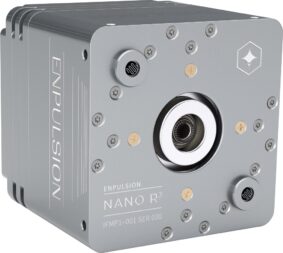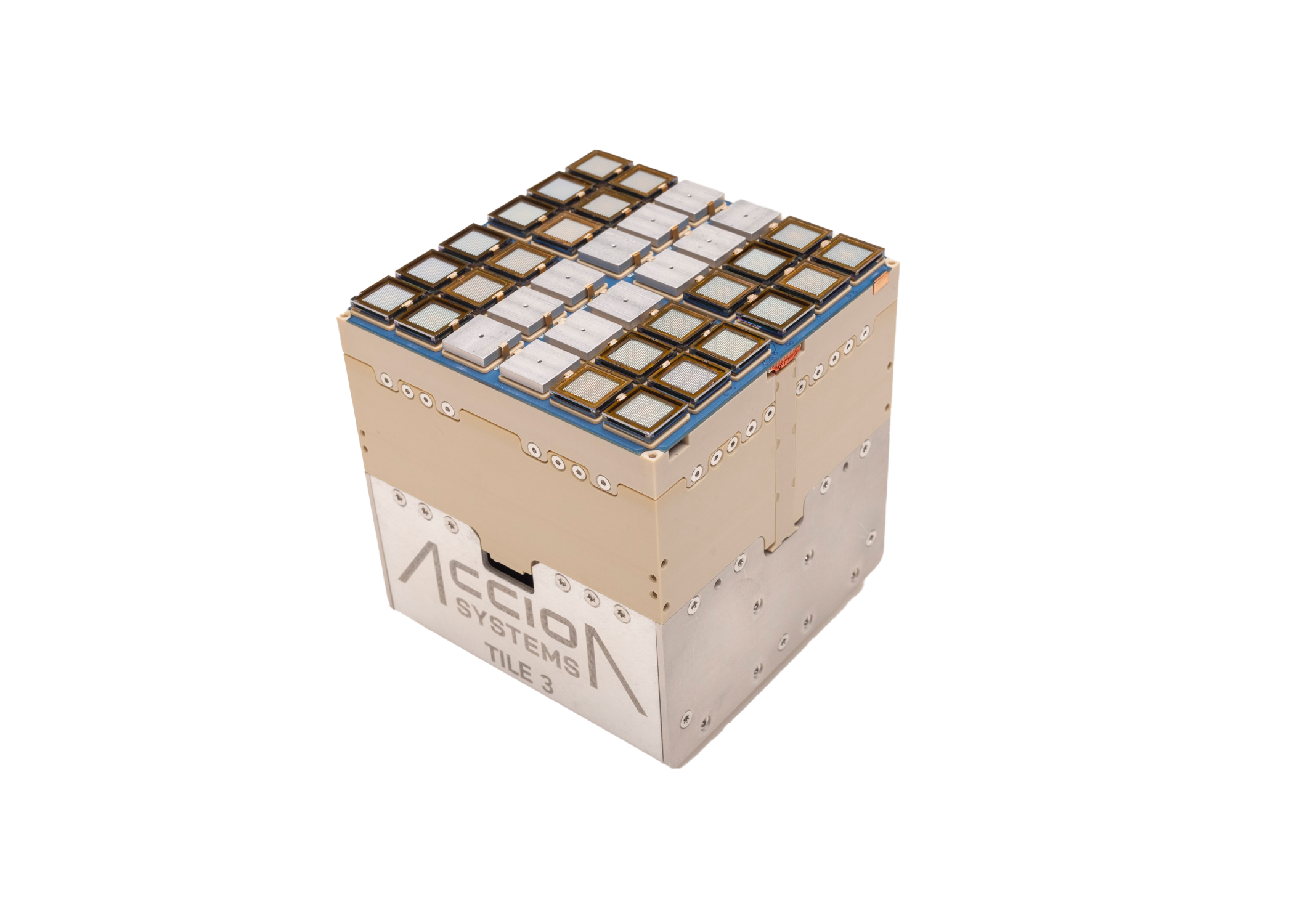Small satellite propulsion has a critical role to play in keeping space sustainable.
While in-orbit debris cleaners and other emerging capabilities capture imaginations, thrusters underpin a healthy operating environment in space.
Onboard thrusters can help ensure a satellite safely reaches its assigned orbit, moves out of harm’s way, relocates as market and mission requirements warrant, and dispose of itself when the time comes.
It is partly why the rise of smallsat constellations has spawned dozens of propulsion startups promising more efficient thruster as concerns over congested orbits grow.
Ensuring space sustainability means giving satellite operators more propulsion capabilities for managing their constellations, according to István Lőrincz, co-founder and president of propulsion startup Morpheus Space.
“You cannot talk about space sustainability without talking about propulsion,” Lőrincz said.

As more satellites are added to low Earth orbit, he believes it will be increasingly crucial for smaller spacecraft to have the means to maneuver within their constellations.
Smallsats might need to dodge malfunctioning spacecraft and debris, or shift their position to heal an issue somewhere else on the network.
Lőrincz believes operators will be increasingly incentivised to deorbit spent satellites faster as constellations grow, enabling them to be replaced more efficiently and maintain or even improve service levels.
Constellations relying on intersatellite links, in particular, will want to minimize costs by limiting the number of satellites they send to space, he said, but risk “serious outages” if a spacecraft is lost and the network cannot be adjusted to compensate.“[T]o replace a malfunctioning satellite, you would have to remove it first, and obviously you want to perform that as fast and as coordinated as possible,” he said.
But for now, and in the absence of globally accepted orbital stewardship rules and incentives, he said spending resources to speed up a retired satellite’s atmospheric reentry is more about burnishing an operator’s corporate image than its bottom line.
Still, there are growing calls for international cooperation to enforce standardized rules for space operations. The World Economic Forum is developing a Space Sustainability Rating system, which scores companies based on factors including post-mission deorbit plans and collision-avoidance measures. Missions that voluntarily participate in the system would earn a certification and rating based on how they contribute to space sustainability.
NEW OPERATING ENVIRONMENT
While onboard propulsion is typical for large satellites that have provided vital services for decades, it is not as commonplace among smallsats that have relatively only recently graduated from experimental to commercial roles.
The satellites AAC Clyde Space is building for Eutelsat will use onboard propulsion for phasing, stationkeeping and collision avoidance.
“I think we’ll start seeing that more and more,” said Luis Gomes, AAC Clyde Space CEO.
“I suspect collision avoidance will become a mandatory requirement from licensing countries.”
Rules for avoiding collisions may apply, for example, to satellites operating at altitudes above 400 kilometers. Similarly, satellites operating at 600 kilometers or higher may be required to have some way to deorbit, or at least to move below the International Space Station’s altitude before deorbiting passively.
Increasingly, nanosatellites programs backed by U.S. or European government agencies require some propulsion.
“They want to see how we are going to mitigate the risk of collision with space junk,” said Vytenis Buzas, NanoAvionics CEO and co-founder.
“People are starting to talk about that and about ways to reduce the orbital altitude after the satellite is no longer operational, including propulsion, tethers and other deorbiting devices.”
If agencies mandate collision avoidance capabilities, they will need to offer clear explanations of the scenarios they envision, noted Brad King, Orbion Space Technology CEO and founder.
“If I’m trying to avoid a collision that might happen next month, that maneuver is very different than if I’m trying to avoid a collision that might happen in the next hour or so,” King said.
Orbion is developing a thruster uniquely designed for collision avoidance. While electric propulsion is extremely fuel-efficient — and thus a popular option for especially volume-constrained satellites — it is unlikely to provide enough on-demand thrust to avoid a collision without substantial lead time.
“Most electric propulsion technologies just can’t get out of the way in time even if you stomp on the accelerator,” he said. “We have a feature we added to our system that resolves that issue.”
Five years ago when Austria’s Enpulsion began developing nanosatellite thrusters, cubesats had few propulsion options. Now, companies are beginning to flight test a wide variety of chemical and electric propulsion systems sized for a growing population of relatively tiny satellites.
At the same time, regulators are beginning to insist satellites actively deorbit at the end of missions.
OIL SPILLS ARE BAD FOR BUSINESS
Companies concerned about their reputations don’t want to be seen as bad for the environment.
A satellite that crashes into something during deorbit because it does not have sufficient propulsion to control its descent would be a business-hurting PR disaster, to say the least. Oil spills on Earth, after all, tend to be bad for business.
But adding more propulsion capabilities means additional costs for a satellite operator.
A satellite devoting more of its power budget to thrusters has less available for running cameras, transponders, or other payloads central to generating revenue or meeting its mission.
Propulsion startups targeting the smallsat market aim to introduce affordable, efficient thrusters that provide plenty of boost without overtaxing a satellite operator’s finite resources — namely money, mass, onboard power and fuel.
Morpheus co-founder Lőrincz said propulsion companies like his “should be obligated to make their offering so enticing that sustainable operations have no significant impact on the bottom line. Or even better, that adopting propulsion is helping the business and this is what we set out to do.”
Morpheus was the only space mobility propulsion venture to win LEO constellation operator OneWeb’s innovation challenge in July.
Lőrincz said it is in a co-engineering phase with OneWeb to support the operator’s second-generation constellation.
AVOIDING SPACE EXPLOSIONS
More power-efficient thrusters could mean a satellite can move while imaging or communicating without putting undue strain on its batteries or solar cells.
That opens up new applications for different types of satellites, according to space propulsion startup Accion Systems, which recently sold a majority stake of the venture to private equity for $42 million.
The type of propulsion is also an important factor in space sustainability, noted Accion Chief Technology Officer Natalya Bailey.
Using a combination of liquid and electric propulsion for thrusters enables Accion’s system to be unpressurized, unlike some others that have to manage pressurized gas containment technology.
Bailey said the ability of its Tiled Ionic Liquid Electrospray (TILE) thrusters to eliminate the need for pressurized fuel tanks and high energy systems will become increasingly important as satellite population grows.
“We’re not needing to launch little bombs into orbit that have the potential to not only destroy a customer’s own constellation, if there’s a chain reaction of explosions, but they could also really muck up LEO for everybody else as well,” she said.
Debra Werner contributed to this story from San Francisco.
This article originally appeared in the August 2021 issue of SpaceNews magazine.
